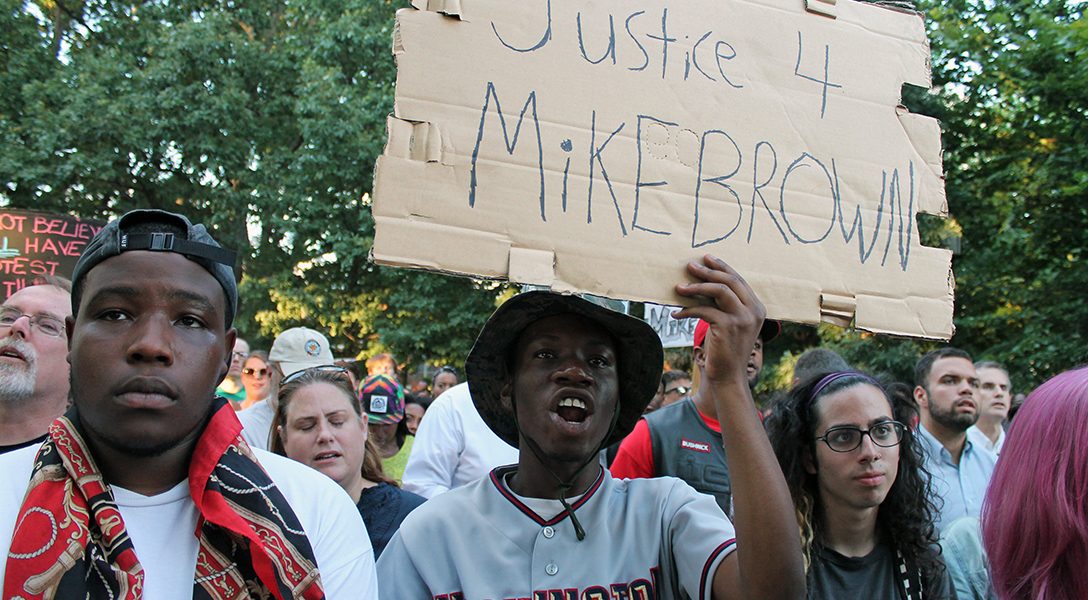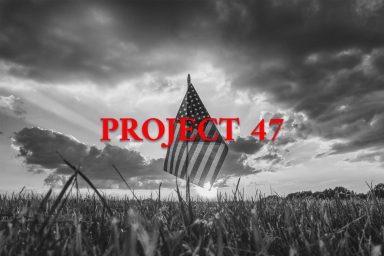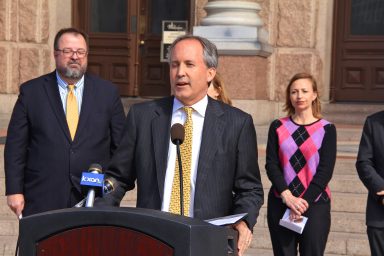A close look at what set off the Ferguson riots five years ago, and a closer look at the long-term abuse and predation the police subjected black citizens to every day.
Five years ago, on August 9, 2014, a policeman shot an unarmed black man in Ferguson, MO, under circumstances that are still not clear. A grand jury concluded the shooting was justified. This led to more than a week of protests and rioting, with a heavy-handed, militarized response from the police, even when protests were peaceful.
Below are three videos that provide close-up views of what it was like to be in the midst of these confrontations.
Further below is a detailed description of what happened that day, followed by excerpts from a book put out by the Civil Rights Division of the Justice Department, The Ferguson Report.
How Did it Start?
The following is based mostly on the Department of Justice’s investigation of the shooting.
According to Ferguson authorities, the victim, 18-year-old Michael Brown, attacked a policeman, provoking a deadly response.
An earlier incident seems to reveal the shooting victim’s state of mind which may account for his apparently fearless behavior. According to his autopsy, enough marijuana was in his bloodstream to have impaired his judgment.
“Fearless” because of the Ferguson police’s long history of racism, abuse, intimidation, and worse.
Brown and his friend Dorian Johnson had gone into a store, took several packages of cigarillos and headed toward the door. A clerk tried to stop him, but Brown shoved him aside. This much is shown on a surveillance video. Later, store employees reported that Brown looked “crazy” and said, “What you gonna do?”
The two men left the store and were walking in the middle of the street when Officer Darren Wilson, already in the neighborhood, spotted them and, according to Johnson, said, “Get the fuck on the sidewalk.”
Wilson, who had heard of the robbery and thought the two men matched the descriptions of the suspects, called for backup and parked his car at an angle, barricading the roadway. Then Wilson tried to open his door but, suddenly, Brown was blocking his way.
Brown — who was 6 feet 5 inches, and weighed 300 pounds — is alleged to have reached into the car, grabbed Wilson, and punched him. According to Wilson, he pulled out his gun, and Brown tried to grab it, saying “You are too much of a pussy to shoot.”
Brown put his right hand over Wilson’s, but Wilson was able to maneuver the gun so that it was aimed at Brown’s hip. After trying three times to fire, the gun went off. The bullet wounded Brown’s right thumb and ended up lodged inside of the car door. Wilson said Brown was momentarily startled, then became enraged, and leaned into the driver’s window so that his head and arms were inside the SUV and he assaulted Wilson again. Wilson fired again, but did not know where that bullet went.
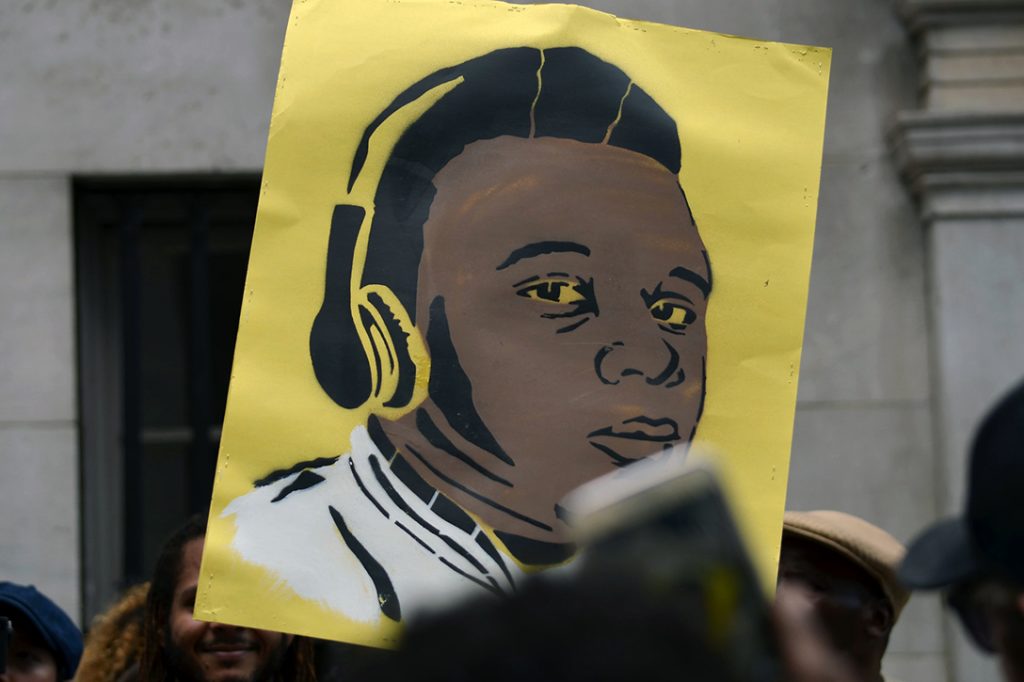
Photo credit: Felton Davis / Flickr (CC BY 2.0)
Much of this is corroborated by physical evidence. According to the DOJ, Brown’s DNA was found on the inside of the driver’s-side door, and on Wilson’s collar, shirt, and pants. Soot from the gun’s muzzle was found in Brown’s wound, indicating that his hand was within inches of the gun when it fired.
Brown took off running. After calling for backup, Wilson went after him. What happened next is the most controversial part of the story. Here is Wilson’s version: Brown ran for about 20 to 30 feet, abruptly turned around and charged Wilson, who had asked him multiple times to stop and get on the ground. As Brown got nearer, he reached into his waistband. Wilson fired several shots at him as he approached, none of which seemed to have had any effect on Brown. So he continued to fire.
When he was within eight to ten feet of Wilson, Brown leaned forward as though getting ready to tackle Wilson, and Wilson fired the last shot.
The body lay for four hours on the hot asphalt because, officials say, they were afraid of the gathering crowds bent on revenge.
What the Autopsy Proves
Many witnesses said Wilson shot Brown in the back, but the autopsy disproves this.
All of the shots, with one possible exception, hit Brown in the front. (Only the back of his right forearm below the elbow was hit, which could have happened if the arm had been bent at the elbow upwards.) Brown was shot twice in the chest, and twice in the right upper arm. Then two shots to the head, one fatal.
Regarding the last shot, Brown could have been in a crouching — ready to tackle — position as described by Wilson:
The fatal bullet entered the skull, the brain, and the base of the skull, and came to rest in the soft tissues of the right face. The trajectory of the bullet was downward, forward, and to the right. Brown could not have been standing straight when Wilson fired this bullet because Wilson is slightly shorter than Brown. Brown was likely bent at the waist or falling forward when he received this wound. It is also possible, although not consistent with credible eyewitness accounts, that Brown had fallen to his knees with his head forward when Wilson fired this shot. However, the lack of stippling and soot indicates that Wilson was at least two to three feet from Brown when he fired.
The pathologists said this shot had to have been the last, because it would have instantly killed Brown, and he would have been unable to continue charging at Wilson.
What No Autopsy Could Show
There was a claim, either true or false, that before he was shot, Brown had put his hands up in surrender. This led to a slogan chanted by the protestors: “Hands up, don’t shoot!.”
Wilson and many “credible” witnesses deny this. Witnesses were labeled by the DOJ as “not credible” if they changed their stories too radically. If you read the DOJ report, you may agree with this assessment.
But in too many other cases, unarmed, non-threatening black people have been shot — while surrendering, while running away, or just for holding something in their hands that a policeman feared was a weapon, like a cellphone, a set of keys, a wallet, a candy bar, a toy, a shadow.
A Whole Police Department Is Indicted
In addition to the Department of Justice investigation into the shooting itself, its Civil Rights Division investigated the Ferguson Police Department, which revealed wide-spread corruption and a crushing abuse of power as documented in The Ferguson Report.
This damning report led to many changes. For instance, the number of black police officers went from only four to 21, and Ferguson now has a black chief of police. But, as the New York Times put it recently, “Despite five years of changes in Missouri, black drivers continue to be stopped at much higher rates than white drivers in communities throughout the state.”
Below we present excerpts from The Ferguson Report — a scathing, detailed account of relentless abuse in multiple forms, verbal, physical, and financial. (This was first published July 29, 2015.)
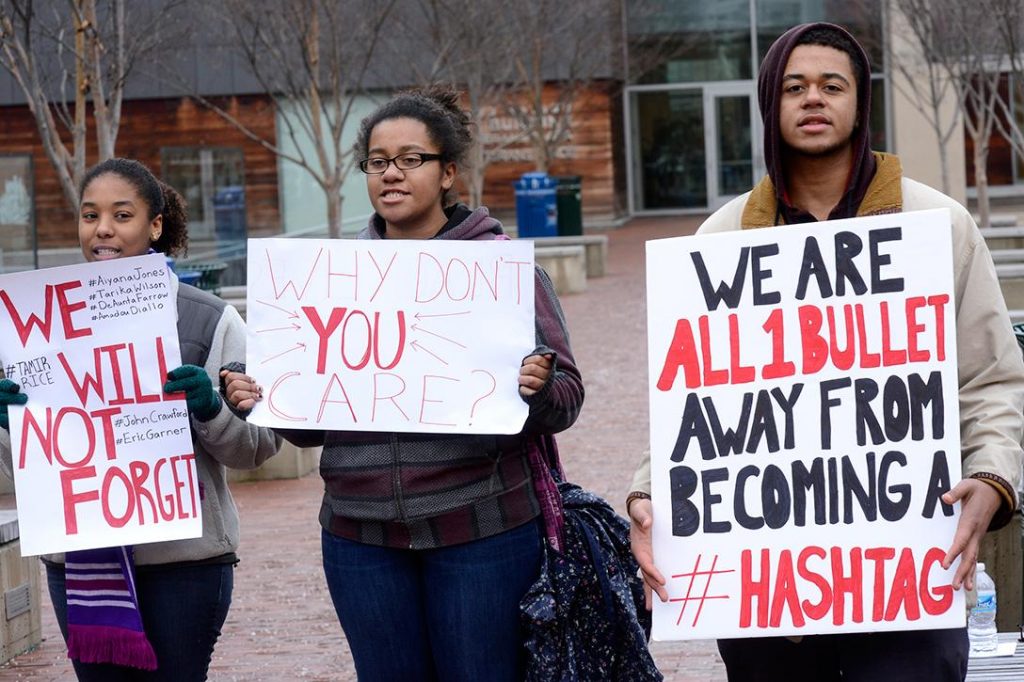
The shooting of Michael Brown sparked protests all over the country, including this one in Silver Spring, Maryland. Photo credit: Steven Melkisethian / Flickr (CC BY-NC-ND 2.0)
Conservative Newt Gingrich — of all people — said something surprisingly insightful soon after a black man went on a rampage and shot several policemen In Dallas.
“If you are a normal white American, the truth is you don’t understand being black in America, and you instinctively under-estimate the level of discrimination and the level of additional risk.”
And he explained that it took him a long time, with a number of people talking to him over the years, before he finally got that sense of reality.
To give our readers a vivid sense of that reality, we are once again publishing excerpts from The Ferguson Report. This was first published July 29, 2015.
***
It has been said that African-Americans are often arrested for “driving while black.” In fact, African-Americans seem to be arrested for walking, talking—or just breathing—while black.
This is not news. What is news is that the Department of Justice investigated the city, the police department, and the judicial system of Ferguson, Missouri—which is apparently just one of many places in America where such racially-driven abuses occur on a regular basis.
Out of this came The Ferguson Report.
Here we present anecdotes from that report, a catalog of daily harassments, humiliations—and worse—by a police department intent on keeping a people “in their place” while earning revenue for the city by writing as many tickets as possible.
Theodore M. Shaw—Julius L. Chambers Distinguished Professor of Law and Director of the Center for Civil Rights at the University of North Carolina—wrote an eloquent introduction to the Report. In it, he said the DOJ pursued the investigation in order to understand the context in which the events following the shooting of Michael Brown took place. Even if Darren Wilson [the officer who shot Brown] was not criminally indicted, in a broader sense the City of Ferguson, Missouri, stood indicted for its unconstitutional and racially discriminatory actions, deeds, and omissions in its daily treatment of its African-American citizens.
Below are selections from the Report. They have been edited and compressed to fit space requirements.
(This is a two-part series, and Part 2 can be found here.)
—WhoWhatWhy Introduction by Milicent Cranor
EXCERPTS FROM THE FERGUSON REPORT
Attitudes in Writing
We have discovered evidence of racial bias in emails sent by Ferguson officials, all of whom are current employees, almost without exception through their official City of Ferguson email accounts, and apparently sent during work hours. These email exchanges involved several police and court supervisors, including *FPD supervisors and commanders. The following emails are illustrative:
An October 2011 email included a photo of a bare-chested group of dancing women, apparently in Africa, with the caption, “Michelle Obama’s High School Reunion.”
• A November 2008 email stated that President Barack Obama would not be President for very long because “what black man holds a steady job for four years.”
• A March 2010 email mocked African Americans through speech and familial stereotypes, using a story involving child support. One line from the email read: “I be so glad that dis be my last child support payment! Month after month, year after year, all dose payments!”
• An April 2011 email depicted President Barack Obama as a chimpanzee.
• A May 2011 email stated: “An African-American woman in New Orleans was admitted into the hospital for a pregnancy termination. Two weeks later she received a check for $5,000. She phoned the hospital to ask who it was from. The hospital said, ‘Crimestoppers.’ ”
• A June 2011 email described a man seeking to obtain “welfare” for his dogs because they are “mixed in color, unemployed, lazy, can’t speak English and have no frigging clue who their Daddies are.”
• A December 2011 email included jokes that are based on offensive stereotypes about Muslims.
Attitudes in Action: Violations of Rights Under the First Amendment
FPD’s [Ferguson Police Department’s] approach to enforcement results in violations of individuals’ First Amendment rights. FPD arrests people for a variety of protected conduct: people are punished for talking back to officers, recording public police activities, and lawfully protesting perceived injustices.
For example, one afternoon in September 2012, an officer stopped a 20-year-old African- American man for dancing in the middle of a residential street. The officer obtained the man’s identification and ran his name for warrants. Finding none, he told the man he was free to go. The man responded with profanities. When the officer told him to watch his language and reminded him that he was not being arrested, the man continued using profanity and was arrested for Manner of Walking in Roadway.
***
In February 2014, officers responded to a group of African-American teenage girls “play fighting” (in the words of the officer) in an intersection after school. When one of the schoolgirls gave the middle finger to a white witness who had called the police, an officer ordered her over to him.
One of the girl’s friends accompanied her. Though the friend had the right to be present and observe the situation— indeed, the offense reports include no facts suggesting a safety concern posed by her presence—the officers ordered her to leave and then attempted to arrest her when she refused. Officers used force to arrest the friend as she pulled away. When the first girl grabbed an officer’s shoulder, they used force to arrest her, as well.
Officers charged the two teenagers with a variety of offenses, including: Disorderly Conduct for giving the middle finger and using obscenities; Manner of Walking for being in the street; Failure to Comply for staying to observe; Interference with Officer; Assault on a Law Enforcement Officer; and Endangering the Welfare of a Child (themselves and their schoolmates) by resisting arrest and being involved in disorderly conduct.
This incident underscores how officers’ unlawful response to activity protected by the First Amendment can quickly escalate to physical resistance, resulting in additional force, additional charges, and increasing the risk of injury to officers and members of the public alike.
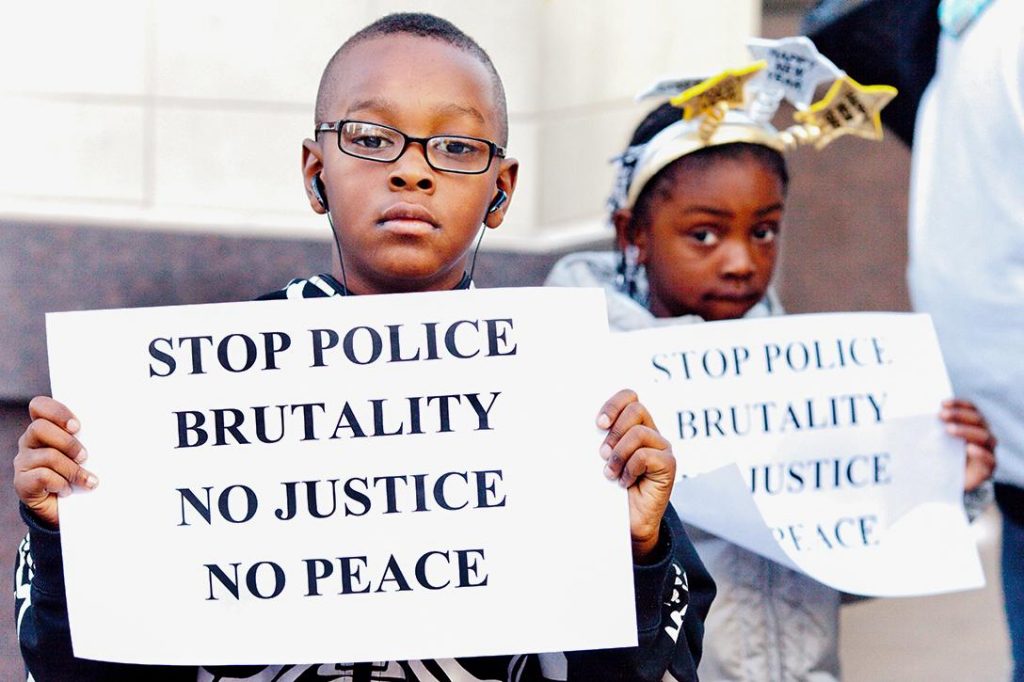
Photo credit: Thomas Hawk / Flickr (CC BY-NC 2.0)
FPD officers also routinely infringe on the public’s First Amendment rights by preventing people from recording their activities. The First Amendment “prohibit[s] the government from limiting the stock of information from which members of the public may draw.”
In Ferguson, however, officers claim without any factual support that the use of camera phones endangers officer safety.
In May 2014, an officer pulled over an African-American woman who was driving with her two sons. During the traffic stop, the woman’s 16-year-old son began recording with his cell phone. The officer ordered him to put down the phone and refrain from using it for the remainder of the stop. The officer claimed this was “for safety reasons.”
The situation escalated, apparently due to the officer’s rudeness and the woman’s response. According to the 16 year old, he began recording again, leading the officer to wrestle the phone from him. Additional officers arrived and used force to arrest all three civilians under disputed circumstances that could have been clarified by a video recording.
***
In June 2014, an African-American couple who had taken their children to play at the park allowed their small children to urinate in the bushes next to their parked car. An officer stopped them, threatened to cite them for allowing the children to “expose themselves,” and checked the father for warrants. When the mother asked if the officer had to detain the father in front of the children, the officer turned to the father and said, “You’re going to jail because your wife keeps running her mouth.”
The mother then began recording the officer on her cell phone. The officer became irate, declaring, “You don’t videotape me!” As the officer drove away with the father in custody for “parental neglect,” the mother drove after them, continuing to record. The officer then pulled over and arrested her for traffic violations. When the father asked the officer to show mercy, he responded, “No more mercy, since she wanted to videotape,” and declared “Nobody videotapes me.” The officer then took the phone, which the couple’s daughter was holding.
After posting bond, the couple found that the video had been deleted. A month later, the same officer pulled over a truck hauling a trailer that did not have operating tail lights. The officer asked for identification from all three people inside, including a 54-year-old white man in the passenger seat who asked why. “You have to have a reason. This is a violation of my Fourth Amendment rights,” he asserted.
The officer, who characterized the man’s reaction as “suspicious,” responded, “The reason is, if you don’t hand it to me, I’ll arrest you.” The man provided his identification. The officer then asked the man to move his cell phone from his lap to the dashboard, “for my safety.” The man said, “Okay, but I’m going to record this.” Due to nervousness, he could not open the recording application and quickly placed the phone on the dash. The officer then announced that the man was under arrest for Failure to Comply.
At the end of the traffic stop, the officer gave the driver a traffic citation, indicated at the other man, and said, “You’re getting this ticket because of him.” Upon bringing that man to the jail, someone asked the officer what offense the man had committed. The officer responded, “He’s one of those guys who watches CNBC too much about his rights.” The man did not say anything else, fearing what else the officer might be capable of doing. He later told us, “I never dreamed I could end up in jail for this. I’m scared of driving through Ferguson now.”
Attitudes in Action: Violations of Rights Under the Fourth Amendment
The Fourth Amendment protects individuals from unreasonable searches and seizures. The Fourth Amendment permits law enforcement officers to briefly detain individuals for investigative purposes if the officers possess reasonable suspicion that criminal activity is afoot. In addition, if the officer reasonably believes the person with whom he or she is dealing is armed and dangerous, the officer may conduct a protective search or frisk of the person’s outer clothing.
“We found numerous incidents in which—based on the officer’s own description of the detention—an officer detained an individual without articulable reasonable suspicion of criminal activity.”
In reviewing FPD records, we found numerous incidents in which— based on the officer’s own description of the detention—an officer detained an individual without articulable reasonable suspicion of criminal activity or arrested a person without probable cause. In none of these cases did the officer explain or justify his conduct.
Many of the unlawful stops we found appear to have been driven, in part, by an officer’s desire to check whether the subject had a municipal arrest warrant pending. Several incidents suggest that officers are more concerned with issuing citations and generating charges than with addressing community needs.
In October 2012, police officers pulled over an African-American man who had lived in Ferguson for 16 years, claiming that his passenger-side brake light was broken. The driver happened to have replaced the light recently and knew it to be functioning properly. Nonetheless, according to the man’s written complaint, one officer stated, “Let’s see how many tickets you’re going to get,” while a second officer tapped his Electronic Control Weapon (“ECW”) on the roof of the man’s car.
The officers wrote the man a citation for “tail light/reflector/license plate light out.” They refused to let the man show them that his car’s equipment was in order, warning him, “Don’t you get out of that car until you get to your house.” The man, who believed he had been racially profiled, was so upset that he went to the police station that night to show a sergeant that his brakes and license plate light worked.
At times, the constitutional violations are even more blatant. An African-American man recounted to us an experience he had while sitting at a bus stop near Canfield Drive. According to the man, an FPD patrol car abruptly pulled up in front of him. The officer inside, a patrol lieutenant, rolled down his window and addressed the man:
Lieutenant: Get over here.
Bus Patron: Me?
Lieutenant: Get the f*** over here. Yeah, you.
Bus Patron: Why? What did I do?
Lieutenant: Give me your ID.
Bus Patron: Why?
Lieutenant: Stop being a smart ass and give me your ID.
The lieutenant ran the man’s name for warrants. Finding none, he returned the ID and said, “Get the hell out of my face.”
***
While the record demonstrates a pattern of stops that are improper from the beginning, it also exposes encounters that start as constitutionally defensible but quickly cross the line. For example, in the summer of 2012, an officer detained a 32-year-old African-American man who was sitting in his car cooling off after playing basketball. The officer arguably had grounds to stop and question the man, since his windows appeared more deeply tinted than permitted under Ferguson’s code.
Without cause, the officer went on to accuse the man of being a pedophile, prohibit the man from using his cell phone, order the man out of his car for a pat-down despite having no reason to believe he was armed, and ask to search his car.
When the man refused, citing his constitutional rights, the officer reportedly pointed a gun at his head, and arrested him. The officer charged the man with eight different counts, including making a false declaration for initially providing the short form of his first name (e.g., “Mike” instead of “Michael”) and an address that, although legitimate, differed from the one on his license. The officer also charged the man both with having an expired operator’s license, and with having no operator’s license in possession. The man told us he lost his job as a contractor with the federal government as a result of the charges.
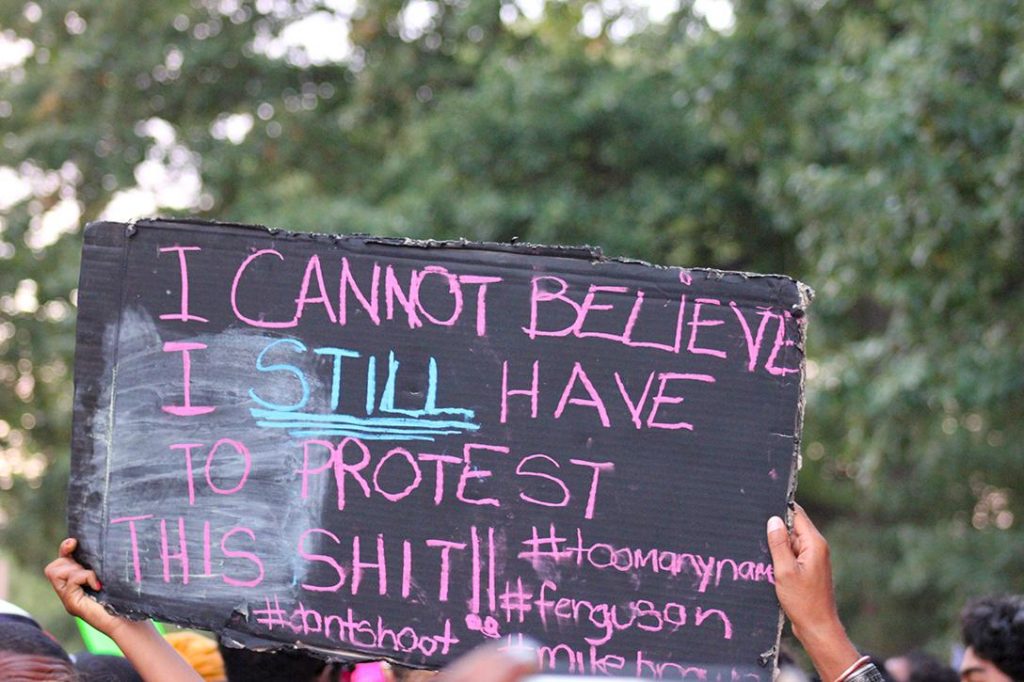
Photo credit: Elvert Barnes / Flickr (CC BY-SA 2.0)
FPD engages in a pattern of excessive force in violation of the Fourth Amendment. Many officers are quick to escalate encounters with subjects they perceive to be disobeying their orders or resisting arrest. They have come to rely on ECWs, specifically Tasers®, where less force—or no force at all— would do. They also release canines on unarmed subjects unreasonably and before attempting to use force less likely to cause injury. Some incidents of excessive force result from stops or arrests that have no basis in law. Others are punitive and retaliatory.
In December 2011, officers deployed a canine to bite an unarmed 14-year-old African-American boy who was waiting in an abandoned house for his friends. Four officers, including a canine officer, responded to the house mid- morning after a caller reported that people had gone inside. Officers arrested one boy on the ground level.
Describing the offense as a burglary in progress even though the facts showed that the only plausible offense was trespassing, the canine officer’s report stated that the dog located a second boy hiding in a storage closet under the stairs in the basement. The officer peeked into the space and saw the boy, who was 5’5″ and 140 pounds, curled up in a ball, hiding.
According to the officer, the boy would not show his hands despite being warned that the officer would use the dog. The officer then deployed the dog, which bit the boy’s arm, causing puncture wounds. According to the boy, with whom we spoke, he never hid in a storage space and he never heard any police warnings. He told us that he was waiting for his friends in the basement of the house, a vacant building where they would go when they skipped school.
The boy approached the stairs when he heard footsteps on the upper level, thinking his friends had arrived. When he saw the dog at the top of the steps, he turned to run, but the dog quickly bit him on the ankle and then the thigh, causing him to fall to the floor. The dog was about to bite his face or neck but instead got his left arm, which the boy had raised to protect himself.
FPD officers struck him while he was on the ground, one of them putting a boot on the side of his head. He recalled the officers laughing about the incident afterward.
The lack of sufficient documentation or a supervisory force investigation prevents us from resolving which version of events is more accurate. However, even if the officer’s version of the force used were accurate, the use of the dog to bite the boy was unreasonable.
Though described as a felony, the facts as described by the officer, and the boy, indicate that this was a trespass—kids hanging out in a vacant building. The officers had no factual predicate to believe the boy was armed. The offense reports document no attempt to glean useful information about the second boy from the first, who was quickly arrested.
By the canine officer’s own account, he saw the boy in the closet and thus had the opportunity to assess the threat posed by this 5’5″ 14 year old. Moreover, there were no exigent circumstances requiring apprehension by dog bite. Four officers were present and had control of the scene.
***
In December 2012, a 16-year-old African-American boy suspected of stealing a car fled from an officer, jumped several fences, and ran into a vacant house. A second officer arrived with a canine, which reportedly located the suspect hiding in a closet.
Without providing a warning outside the closet, the officer opened the door and sent in the dog, which bit the suspect and dragged him out by the legs.
The first officer, who was also on the scene by this point, deployed his ECW against the suspect three times as the suspect struggled with the dog, which was still biting him. The offense reports provide only minimal explanation for why apprehension by dog bite was necessary.
The pursuing officer claimed the suspect had “reached into the front section of his waist area,” but the report does not say that he relayed this information to the canine officer, and no weapon was found. Moreover, given the lack of a warning at the closet, the use of the dog and ECW at the same time, and the application of three ECW stuns in quick succession, the officers’ conduct raises the possibility that the force was applied in retaliation for leading officers on a chase.
***
In November 2013, an officer deployed a canine to bite and detain a fleeing subject even though the officer knew the suspect was unarmed. The officer deemed the subject, an African-American male who was walking down the street, suspicious because he appeared to walk away when he saw the officer.
The officer stopped him and frisked him, finding no weapons. The officer then ran his name for warrants. When the man heard the dispatcher say over the police radio that he had outstanding warrants—the report does not specify whether the warrants were for failing to appear in municipal court or to pay owed fines, or something more serious—he ran.
The officer followed him and released his dog, which bit the man on both arms. The officer’s supervisor found the force justified because the officer released the dog “fearing that the subject was armed,” even though the officer had already determined the man was unarmed.
***
In January 2013, a patrol sergeant stopped an African- American man after he saw the man talk to an individual in a truck and then walk away.
The sergeant detained the man, although he did not articulate any reasonable suspicion that criminal activity was afoot. When the man declined to answer questions or submit to a frisk—which the sergeant sought to execute despite articulating no reason to believe the man was armed—the sergeant grabbed the man by the belt, drew his ECW, and ordered the man to comply.
The man crossed his arms and objected that he had not done anything wrong. Video captured by the ECW’s built-in camera shows that the man made no aggressive movement toward the officer. The sergeant fired the ECW, applying a five- second cycle of electricity and causing the man to fall to the ground. The sergeant almost immediately applied the ECW again, which he later justified in his report by claiming that the man tried to stand up.
The video makes clear, however, that the man never tried to stand—he only writhed in pain on the ground. The video also shows that the sergeant applied the ECW nearly continuously for 20 seconds, longer than represented in his report. The man was charged with Failure to Comply and Resisting Arrest, but no independent criminal violation.
# #
Go here to read The Ferguson Report in its entirety.
Related front page panorama photo credit: Adapted by WhoWhatWhy from police car lights (Robert Couse-Baker / Flickr – CC BY 2.0), Ferguson Police patch (Tysports / Wikimedia – CC BY-SA 4.0) and DOJ seal (Department of Justice / Wikimedia)
